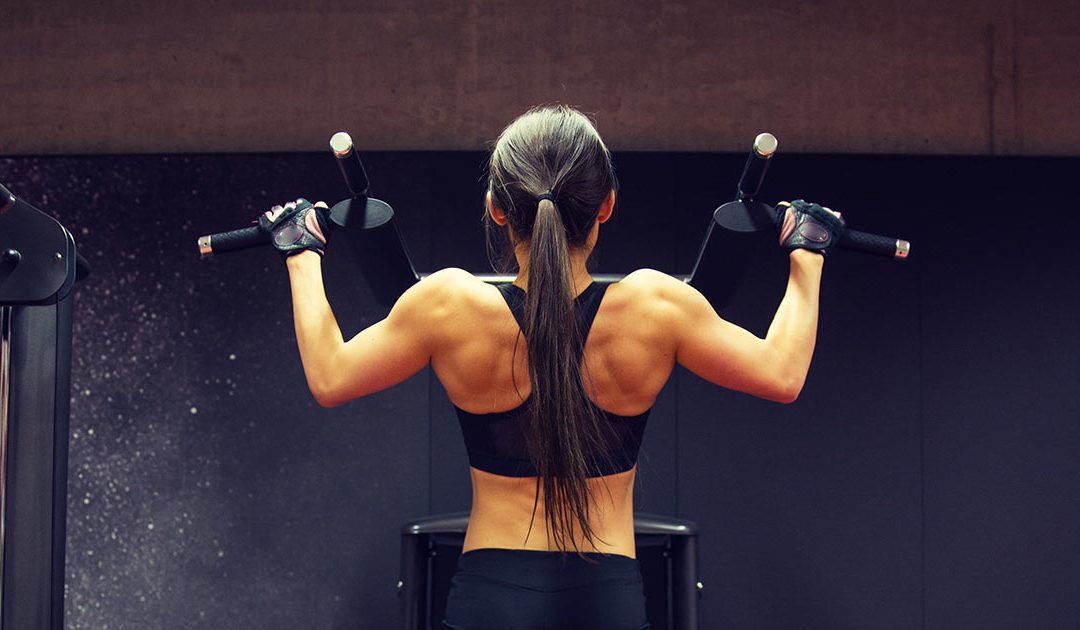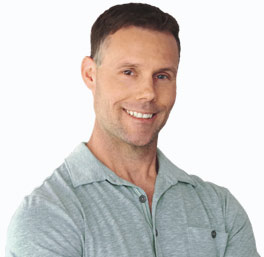A great back workout incorporates all components of your back trained equally.
I encourage all to make sure you’re training your backside equally to your front side. As you age, your posture will suffer without adequate back exercises.
That may not be your priority now, but once you’re in your forties or later, it will be a priority. I assure you! Might as well start the habit as early as possible.
Let’s look at the kinesiology of the back as a generalized overview. Then let’s look at the different regions of the back in the context of exercise. And finally, we’ll review the exercises that can be put into practice for a great back workout.
Glynn’s Guide
Takeaways That Won’t Fail You
- Focus on big compound movements through 100% of the range of motion to minimize imbalances.
- Maintain balance between your posterior side and your anterior side by not training either more often than the other. In other words, avoid 1 back day to 2 chest days.
- The big three back exercises that win in my book are: deadlift, bent barbell row and pull ups.
- The three aspects of the back that incorporate the upper, middle and lower are the cervical vertebrae, the thoracic vertebrae and the lumbar vertebrae.
- Incorporating scapular retraction/depression exercises and rotator cuff exercises is crucial to long term balance and postural alignment.
Kinesiology of the back
I want to take a minute and briefly review the kinesiology of your back. For a more detailed overview, check out my article Get The Best Lat Workouts With These 10 Great Lat Exercises [Get That V].
It’s not necessary to cover the insertions and origins of the muscles in the article. But a basic understanding of kinesiology can really help fuel your training.
The biggest movers in the back
1. Latissimus dorsi (lats)
These form the V taper that is sought after in most. They play several roles:
- Adduction (toward the body) of the shoulder joint.
- Extension (toward the body) of the shoulder joint.
- Internal rotation of the shoulder joint.
- Horizontal abduction of the shoulder joint.
2. Erector spinae
These are the thick muscles you feel on each side of your vertebrae. Their function is the extension and lateral flexion of the spine. Think bending backward and to the side. They play a big role in keeping us upright.
3. Rhomboids
The rhomboids two separate muscles deep to the trapezius and attach the scapula to the vertebrae. Their role is to:
- Retract scapula (pull toward the spine)
- Elevate scapula (pull up toward the head)
- Depression of the glenoid cavity
4. Upper traps
The upper trapezius muscles are what most people think of when referring to traps. They’re very visible in bodybuilders and powerlifters. And they’re often overdeveloped compared to the middle and lower traps. Their role is to:
- Elevate the scapula (the “I don’t know” body language)
- Extend the head. (looking upward)
5. Middle traps
The middle trapezius shares some of the same roles as the upper traps. Their function is to:
- Elevate the scapula (same “I don’t know” movement.)
- Upward rotation of the scapula (part of elevating the shoulder joint)
- Adduction of the scapula (pulling them toward the vertebrae)
6. Low traps
The low trapezius is “the red headed step child” in a lot of exercise programs, i.e., it’s too often overlooked. Its role is crucial for good postural alignment and minimal neck pain. It’s job is:
- Depression of the scapula (pulling the shoulder blades toward the pelvis
- Adduction of the scapula (pulling the scapula toward the vertebrae)
- Upward rotation of the scapula (elevating the shoulder joint)
Role of the rotator cuff
We can’t cover back exercises without discussing the role of the rotator cuff. There are copious amounts of information about strengthening the rotator cuff, so I’ll be brief.
The proper function of the rotator cuff is crucial for a great back workout!
The rotator cuff’s most important role is to keep the humeral head (top of your arm) in the proper location within the shoulder joint (glenoid cavity). If it’s not in the right spot, it will send you plenty of pain signals over time.
There are four small muscles of the rotator cuff that play a big role in back exercises. There are larger supporting muscles that assist or oppose the rotator cuff. There are also a few more small ones that play a role. For the sake of simplicity and sticking to back exercises, we’ll look at the following players.
The four most important are:
- Supraspinatus: It assists with abduction and stabilization of the humeral head.
- Infraspinatus: It externally rotates, extends, horizontally abducts and stabilizes the humeral head.
- Teres Minor: This small muscle also externally rotates, extends, horizontally abducts and stabilizes the humeral head.
- Subscapularis: This larger rotator cuff muscle internally rotates, adducts and extends the whole glenohumeral joint. It also stabilizes the humeral head.
Keeping the muscles strong and flexible is crucial!
Synergistic role of back muscles
Unless you’re bodybuilding, thinking of just one muscle at a time when lifting is a mistake. Your lats might be the focus, but the movement is far more complex.
One also has to consider that flexion of a particular muscle is designed to move a specific bone. And the direction of the movement of that bone may be counterintuitive to the overall exercise.
Regardless, if you move with precision and clean form slowly and you can’t go wrong.
What do I mean by “balanced muscles?”
Think of a large pulley on a crane. Now imagine if one or two of the wires on one side of the pulley were being pulled harder than the other opposing side. In addition, this opposing side has tiny cables with a lower force rating.
And a step further, there are stabilizing wires on the sides being pulled unequally.
What happens over time?
Generally speaking, we’re all born with our fulcrums (joints) in balance. Over time through life habits or poor exercise habits, we get them out of balance. Very few trainers have the level of expertise required to rebalance every muscle group. This requires a great physical therapist.
What’s a good solution you can utilize now without seeing a physical therapist? Focus on big compound movements through 100% range of motion rather than isolated exercises. And avoid training one side of the fulcrum more than the opposing side.
Sections of the back
We’ll separate the back into three components. This is generalized. And many of the muscle groups cross into different sections. But for the sake of lifters looking for answers to these questions, we’ll go with this style.
The upper back incorporates the cervical vertebrae and the upper part of the thoracic vertebrae.
The middle back incorporates the thoracic vertebrae.
The lower back incorporates the lumbar vertebrae
Upper back workout
The following upper back exercises work this region well:
Posterior delt flys
Shrugs (list my caveat)
High rope row
The caveat to shrugs as an exercise
Yes, shrugs will build large and strong upper traps and rhomboids, but it’s really easy to overdevelop these two groups.
What do I mean? The imbalance between scapular elevation and depression becomes excessive. In other words, the strain on the other neck muscles becomes substantial. And over time, shoulder and neck injuries become prominent.
So, if you’re going to shrug heavy, please counter the exercise with scapular depression movements. In other words, exercises that squeeze the scapula together and pull them toward your feet.
Simply squeezing your shoulder blades together and downward during a rowing movement is a big help.
Middle back workouts
The following middle back exercises work the middle back well:
Low trap scapular retraction holds. The objective is to squeeze the bottom of your scapula down and together as hard as possible for ten seconds per hold.
Bent barbell rows
Cable rows (single and double grip)
1 Arm DB row
Low trap on TRX
Pullovers
Cable shoulder extension
Lower back workouts
When we discuss lower back exercises, we’re predominantly referring to the lumbar and hips. I would encourage you to incorporate good core exercises in addition to low back exercises.
The following lower back exercises work the low back well:
Deadlifts
Bridging
Supermans
Best back exercises
If you were headed to a desert island and can only bring three back exercises with you, consider the following.
The top three exercises in my book for your whole back include:
Deadlifts
Bent barbell row
Pull-ups
Best back workout to maintain balance
Here’s an example of a great back workout. The number of sets, reps, and weights should be adjusted based on your goals. This applies to both males and females. Also, I’m assuming a warm up was executed prior to beginning the workout.
4 sets of deadlifts failing in a 4-8 range
4 sets of bent barbell row failing in a 6-8 range
4 sets of pull-ups to failure
3 sets of DB pullovers failing in an 8-10 range
3 sets of scapular retraction hold for 10 seconds in each position.
Back exercises for women
I’ll be brief. There’s no reason to differentiate exercises between men and women. There are some obvious and a few not so obvious mechanical differences, but ultimately, the same exercises apply just fine.
Anyone that tells you there are special exercises just for women or men is just trying to optimize SEO results.
Heavy or light back exercises?
I’m an advocate for heavy training, especially the big compound lifts. I don’t know where the old adage “light for sculpting a heavy for building” came from. But it technically doesn’t apply.
Diet plays a more crucial role in “sculpting.”
Yes, there’s a difference in rep range failure along the strength/hypertrophy curve, but let’s leave out the word “sculpting” please.
Home back workout
At home back workouts are one of the more difficult options. But not impossible. There’s certainly less variety than in the gym, but with some creativity, you can accomplish more than you may think.
And who knows when we’re going to be forced to stay home again. It’s obviously a new reality!
Here are a few exercises that are “outside of the box:”
Pullovers on the floor.
Renegade row with a jug (plank position)
1 arm DB or gallon jug row
1 arm row off a chair
Prone shoulder flexion with can
Prone horizontal abduction with a can
Post delt flys with cans
Pull-ups if you have a bar.
Negative pull-ups if necessary.
How often should you train your back?
If you’re separating out body parts the answer depends on your goals. Twice a week is optimum if you’re not training intensely. But if you’re training heavy and intensely, once a week is best.
I still only train each large muscle group once a week with great results. I’m a fan of spending more time outside the gym than inside the gym.
Conclusion
Again, some of the most important takeaways are to equally work your anterior and posterior sides (front and back) equally. Focusing on the bigger compound (multi-joint) movements will contribute to muscular balance. And always going through 100% of the range of motion with all lifts will help diminish muscular imbalances.
I wish you great future back workouts!
Back Workout FAQs
What back exercise is best?
If I could only choose one, it would be the deadlift. But we have options. So, the deadlift, bent barbell row, and the pull up are my top three.
How many back exercises should I do?
To stay in balance, you should do more exercise for your back than you do for your front side (chest region). I like to do 4-5 exercises for back when it’s separated out on its own. And a minimum of 2 when it’s a full-body workout.
Can back exercises make you taller?
If you have poor posture, a good back workout routine will help realign your posture, making you appear taller. If you already have great posture, then no.
Back exercises without weights?
A few good ones that don’t require weights are scapular retraction and depression, supermans, and bridges. All are shown above.
Back exercises for posture?
Scapular retraction and depression exercises as well as big rowing movement will help improve posture.



